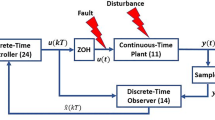Abstract
This paper presents the characteristics of a general structured observer and presents an estimation algorithm for a system with external disturbances which are added to the input of the system. By using a disturbance model, the general structured observer can estimate the states of the system in spite of disturbances, where the system is affected from external disturbances. Also, the general structured observer can include the function of a PI observer or high gain observer by properly adjusting the observer’s gain matrices. The existence condition for the observer is derived, which can be checked by the system’s observability condition and the pole-zero cancellation of the system’s polynomial matrix. Through a numerical example, it is verified that the proposed observer is effective estimating the states of the system and the input disturbance.
Similar content being viewed by others
Abbreviations
- x(t) :
-
State vector of system
- \(\hat x(t)\) :
-
Estimated state vector of system
- d(t) :
-
Input disturbance vector
- \(\hat d(t)\) :
-
Estimated disturbance vector
- e x (t) :
-
Error vector between real states and estimated states
- ξ(t) :
-
Transformed estimated error vector
- ζ(t) :
-
Transformed error vector
- K,H,M,N :
-
Gain matrices of general structured observer
References
Chang, S. K., You, W. T., and Hsu, P. L., 1997, “Design of General Structured Observers for Linear Systems with Unknown Inputs,”J. Franklin Inst. Vol. 334B, No. 2, pp. 213–232.
Edwards, C. and Spurgeon, S. K., 1994, “On the Development of Discontinuous Observers,”Int. J of Control, Vol. 59, No. 5, pp. 1211–229.
Hou, M., Pugh, A. C., Raste, T., and Miler, P. C., 1999, “On Luenberg Observer Design for Constrained Mechanical Systems,”ASME Journal of Dynamic Systems, Measurement, and Control, Vol. 121, pp. 322–326.
Huh Kunsoo and Kwak Byunggil, 1997, “Evaluation of Discrete-Time Well-Conditioned State Observers,”KSME Int. J. Vol. 11, No. 5, pp. 505–512.
Kim, H. S., 1996, “Design of Robust Control System using Proportional Integral Observer,” Ph. D. dissertation, Kumamoto Univ. Japan.
Kim, H. S., Kim, S. B. and Kawaji, S., 1997, “Fault Detection and Isolation of System Using Multiple PI Observers,”Journal of the Korean Society of Precision Engineering. Vol. 14, No. 2, pp. 41–47. (in Korean)
Lee, C. H., Kim, H. S., and Kim, S. B., 2000, “A Study on General Structured Observer,”Journal of the Korean Society of Precision Engineering, Vol. 17, No. 9, pp. 95–101. (in Korean)
Mahmoud, M. S., Soh, Y. C., and Xie, L., 1999, “Observer-Based Positive Real Control of Uncertain Linear Systems,”Automatica, Vol. 35, pp. 749–754.
Saberi, A. and Sannuti, P., 1990, “Observer-based Control of Uncertain Systems with Nonlinear Uncertainties,”Int. J. Control, Vol. 52, No. 5, pp. 1107–1130.
Yi Kyongsu, 1995, “Design of Disturbance Decoupled Bilinear Observer,”KSME Int. Vol. 9, pp. 344–350.
Author information
Authors and Affiliations
Corresponding author
Rights and permissions
About this article
Cite this article
Lee, CH., Shin, MS., Kim, HS. et al. Input disturbance estimation using a general structured observer. KSME International Journal 15, 1609–1615 (2001). https://doi.org/10.1007/BF03185114
Received:
Revised:
Issue Date:
DOI: https://doi.org/10.1007/BF03185114




